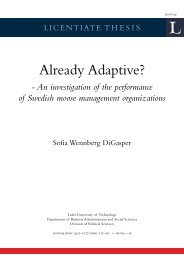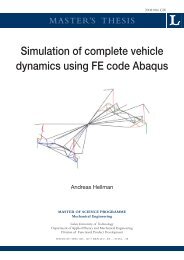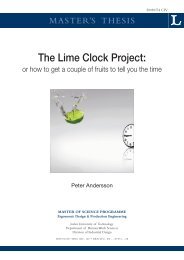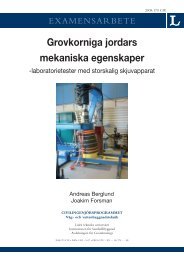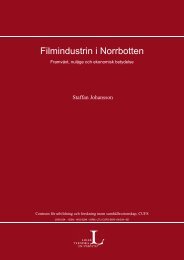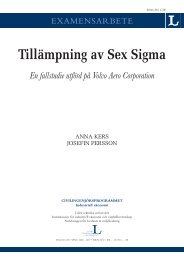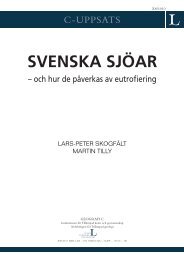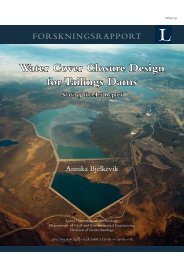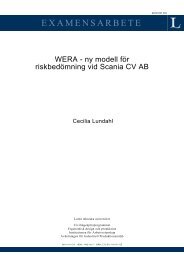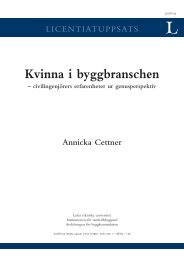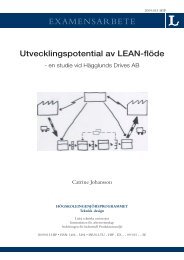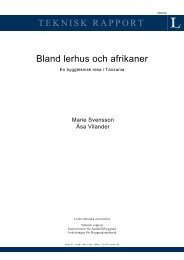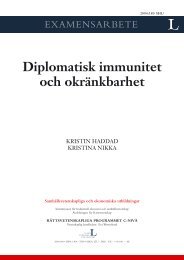LTU - EX - - 10/168 - - SE - Sök - Luleå tekniska universitet
LTU - EX - - 10/168 - - SE - Sök - Luleå tekniska universitet
LTU - EX - - 10/168 - - SE - Sök - Luleå tekniska universitet
Create successful ePaper yourself
Turn your PDF publications into a flip-book with our unique Google optimized e-Paper software.
Abstract<br />
The largest residue in tonnes from the steel production at Ovako in Hofors is the slag from the<br />
electric arc furnace. Until recently the residues were deposited in landfills, but the permit for<br />
the old landfill ran out and instead of building a new one Ovako Hofors has adopted a zero<br />
waste vision. The purpose of the zero vision is to find areas of use for all residues. A possible<br />
use for the electric arc furnace slag is as aggregates in asphalt because the slag has excellent<br />
properties in this field.<br />
The steel production is scrap based, and some of the chromium content in the scrap is<br />
transferred to the slag. It is important to minimize leaching of chromium to be able to use slag<br />
as construction material in an environmentally friendly way. Ovako Hofors is actively<br />
working on decreasing the leaching of chromium. So far progress has been made by<br />
introducing dolomite in the slag forming agents.<br />
Phases capable of stabilizing chromium are spinels and solid solution with MgO. Chromium<br />
in other phases is capable of being leached. If the ratio between CaO/MgO is high enough a<br />
primary solid solution of CaO is formed instead of the wanted primary solid solution of MgO.<br />
With an increased content of FeO it takes a higher CaO/MgO ratio to form the primary solid<br />
solution with CaO according to thermodynamic calculations.<br />
The aim of this thesis is to investigate if it is possible to prevent leaching of chromium by<br />
stabilizing the solid solution of MgO. An increased concentration of iron oxide stabilizes the<br />
solid solutions of MgO according to research done at <strong>Luleå</strong> University of Technology. The<br />
aim is to achieve a ratio between FeO/MgO in the solid solution of at least 50/50.<br />
Thermodynamic calculations show that it is primarily FeO that helps the stabilization of the<br />
solid solution of MgO.<br />
The rate of solidification is important because FeO needs time to be integrated into the solid<br />
solution of MgO before the melt solidifies. When the slag is solidified FeO cannot continue to<br />
be incorporated in the solid solution at the same rate. According to thermodynamic<br />
calculations a higher grade of FeO increases the rate of which FeO can be integrated into the<br />
solid solution of MgO. If this is true the rate of solidification becomes less important with<br />
increasing FeO content.<br />
Three different methods were tested to increase the iron oxide content of the slag. In the first<br />
method a new effective oxygen burner was installed and ran during all experiments. The other<br />
methods used were addition of iron oxide material and additional oxygen. Samples of slag<br />
were taken from both the slag pot and from the floor. The slag from the floor solidifies<br />
quicker than the slag from the pot. For reference measurements old slags were used.<br />
To evaluate the results XRD, <strong>SE</strong>M, leaching and chemical analysis were done. The oxygen<br />
burner increased the iron oxide content while the other two methods did not show any further<br />
influence on the iron oxide content. In most of the samples the leaching of chromium were<br />
under the detection limit of 0,04 mg/kg. Only a few of the samples have leaching of<br />
chromium which indicates that higher iron oxide content does affect the leaching of<br />
chromium in a wanted way.<br />
iii



